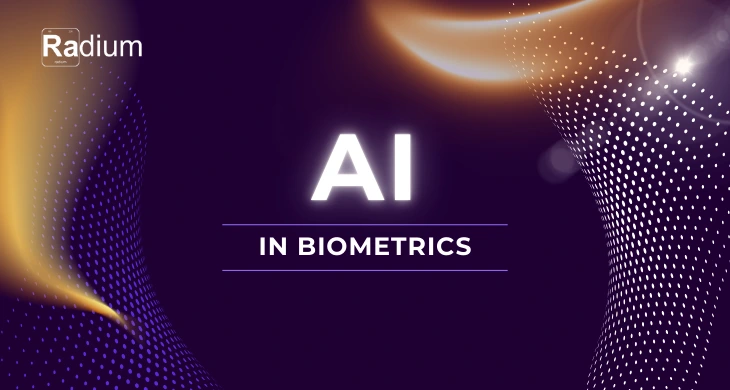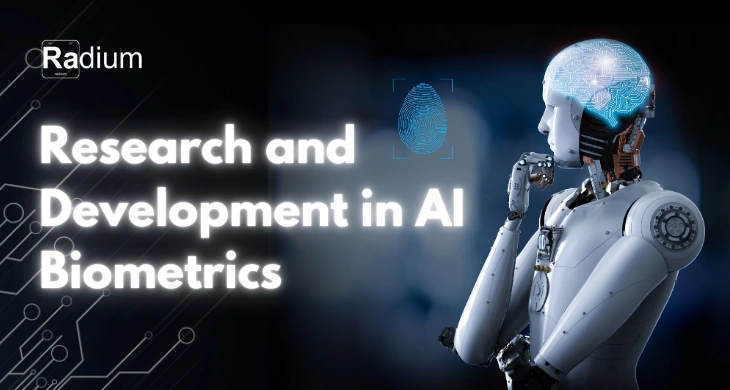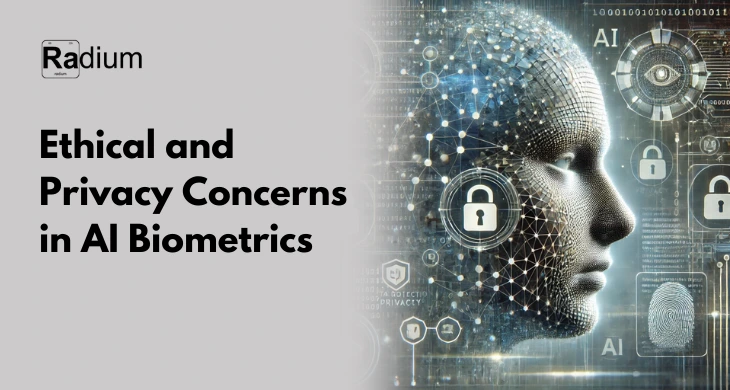
Whether it is assisting in routine chores or making people think about the way they do things in industries as such as biometric identification technology, artificial intelligence surrounds us. Maybe we are years off the possibility of self-conscious AI-powered entities, but AI-based tools never stop being seamlessly integrated into devices and services we use daily-think smartphone or household appliances.
Major organizations include ISO, IEC, NIST, and STQC in this regard, and thus these organizations now utilize the standards based on AI in terms of improving security along with reliability of biometric systems. Researchers have desperately sought AI techniques for their use in identification purposes and thus face, fingerprint, iris, and behavioral-based biometrics. This article has taken a closer inspection on how AI has so far made things wonderful concerning the research in biometric research and the work up till now, ethical matters, privacy issues, along with some potential vulnerabilities it brings.
AI technology essentially transforms biometric systems through improved identification processes and resolution of previously unsolved issues. Let's get at some of the ways in which AI has reshaped core biometric technologies.
1. Face recognition: accuracy and inclusivity
Improved Accuracy: DL and ML enable the systems to properly identify people by analyzing facial characteristics about a person, including his skin tone among others. False accept and false reject rates were very low in most tests with these systems on different populations.
Adaptability to Diverse Features: This can detect the person of any background across different conditions of lights, angles; hence it has made technology robust and inclusive.
Real World Applications: "AI-based face recognition finds its place from unlocking devices to surveillance in high-security zones; hence it has gained mileage nowadays," it said.
2. Fingerprint Recognition: Overcoming Quality and Condition Challenges
AI-Powered Algorithms: Problems that occur in fingerprint recognition arise from skin conditions, damaged fingerprints, or poor image quality. AI, by using advanced ML techniques like ANN and CNNs, can effectively overcome such problems.
Direct Learning from Data: They work based on direct learning from the data, hence the differences in various fingerprint conditions get addressed, and it may increase the recognition accuracy where manual feature extraction-based classical methods fail.
Advanced Applications in Security: Security relevance is still present for industries like banking, law, and personal security, respectively, as fingerprint recognition becomes highly resilient and secure with such a model.
3. Iris Recognition: Security and Sensitivity in Highly Secure Environments
High discrimination resolution: The technology was able to differentiate between life and death, a fact that would be crucial for high-security applications whose sole consideration was the integrity of data.
High degrees of accuracy: For instance, one boasted of a technology that could distinguish a corpse from the living if he had been dead for 16 hours with 99% accuracy.
Application in Government and Defense: It has been widely applied in fields that require high security like government and military identification systems.
4. Behavioral Biometrics: Uncovering Specific Human Behavioral Patterns
Behavioural Features for Identification: AI today controls machines that can identify people using keystroke dynamics, gait, and speech.
Keystroke Dynamics: This AI captures the typing rhythm and speed of a person to create a unique signature that can easily and uniquely identify a person.
Automatic Gait Recognition: This is the detection of a gait feature non-contact when the walking pattern of one person is evaluated for potential application in public security as well as healthcare.
Speech Recognition for Inclusive Security: AI-based speech recognition interprets the human voice and recognizes unique voice patterns to enable applications such as voice-activated assistants and tools that help people with disabilities.
5. Emotion Detection and Concerns Over Privacy
Application of AI in Emotion Detection: Today's AI tries to read microexpressions and facial muscle movements to conclude the presence of what has been perceived as a sentiment. Though the application does involve controversy, such application does indeed comprise an overwhelming area in the overall aspects of monitoring mental health.
Concerns over privacy : The deployment of AI with emotion detection poses many ethics and issues concerning privacy as well. Such matters stand as hindrances while coming up with it within big companies such as Microsoft or Google because of invasion factors.

This type of AI-based biometric technology requires constant study to make it better. Standards are always evolving and so does the need for security and reliability through the regulatory as well as the technical frameworks.
Emerging AI Techniques: Researchers try different techniques like Genetic Algorithms (GA) and Support Vector Machines (SVM) to solve more complex issues in biometrics where the traditional method cannot be followed.
Expanding Security Standards: The leading organizations develop security standards for continuing new standards that allow AI-based biometric systems to adapt to various datasets and real-world challenges.
Anti-Spoofing Measures: As AI progresses so do the techniques to improve security including areas such as liveness detection, ensuring that the authenticity of biometric data exists, and preventing spoofing attempts.
Although it has all the virtues, AI-based biometrics is still insecure to security breaches. DeepMasterPrints and other artificial data generated by AI is a security breach that finds a vulnerability in the technology of biometric identification.
1. DeepMasterPrints and Synthetic Biometrics
Counterfeit Fingerprints: With DeepMasterPrints, researchers may create counterfeit fingerprints that might fool fingerprinting recognition systems and breach any security that is put around consumer technologies.
Potential for Widespread Fraud: That means there is a wide possibility of fraud if synthetic fingerprints are widely used, then there will be large-scale security breaches in the sectors that depend on fingerprint biometrics.
2. Facial recognition security concerns
3D printed masks and spoofing: These AI tools print very real 3D masks. Such masks prove to be a security concern because it fools the facial recognition system. These openings result in fraud, accusations, and cases of identity theft.
Bias and misrecognition: The facial recognition system sometimes fails to identify various demographic groups of people due to the bias introduced by algorithms. These misrecognitions may bring false accusations and even provoke grave implications.
3. Voice Biometrics and Speech Recognition Vulnerabilities
Voice modification attacks: Patterns such as white noise can be used to mislead AI-driven speech recognition systems, resulting in fraud or impersonation.
Voice imitation in fraud: As voice biometrics grows, so
The growing penetration of smartphones is leading to the rise of mobile biometrics and the need for enhanced security and authentication of access to confidential data and information, which is creating numerous growth opportunities for the Biometric Market in India. The consumers are progressively receiving diverse biometric means, for example, fingerprint, facial and voice acknowledgment to confirm their identity. There has been a surge in usage of biometric devices in services under various initiatives by the government of India, including UIDAI (Aadhar), E-Passport, RSBY (Rashtriya Swasthya Bima Yojna), driving permit, and different projects, which, in turn, will push the growth of the market in the coming years. With the increased adoption of mobile devices, consumer biometric applications have grown rapidly in recent years. Because of the adoption of biometric systems, the consumer electronics sector is dominated primarily by security and access control devices. As a result, it promotes market growth. For example, WhatsApp, a popular messaging app, has added a new privacy feature to the Android platform. According to the company, users will soon be able to secure their accounts through biometric authentication via fingerprint sensors.
does the appeal of cybercriminals, who want to use voice imitation for financial fraud and information theft.
4. Direct Attacks to AI Systems
Poisoning AI Models. Malicious actors can introduce contaminated AI models that could trick the system to make mistaken identifications of dangers as harmless.
Difficulty with Model Security. Components that exist in biometric systems from AI are susceptible to exploits that exploit vulnerabilities found within AI itself and are the source of biometric security problems.
India has seen a surge in the adoption of biometric devices across various sectors. Here are some popular biometric devices available in the Indian market:
Fingerprint Scanners: Widely used in smartphones, ATMs, and access control systems.
Facial Recognition Systems: Used in smartphones, surveillance cameras, and public security systems.
Iris Scanners: Employed in high-security areas and government programs like Aadhaar.
Voice Recognition Devices: Used in banking, customer service, and personal assistants.
Hand/Palm Recognition Devices: Utilized in high-security environments and healthcare
Vein Pattern Recognition Devices: Employed in secure access systems and healthcare
The use of AI in biometric devices in the Indian market is rapidly growing, driven by several factors:
Increasing security concerns: Biometric authentication offers a more secure and reliable alternative to traditional methods like passwords and PINs. AI-powered biometric systems can enhance security by detecting spoofing attacks and improving accuracy.
Government initiatives: The Indian government has been actively promoting the use of biometric technology for various purposes, including Aadhaar, a unique identification number for residents. This has led to increased demand for biometric devices.
Rising adoption in various sectors: Biometric devices are being used in a wide range of sectors, including banking, healthcare, and retail. AI-powered biometric systems can streamline processes and improve efficiency in these sectors.
Advancements in AI technology: AI has made significant strides in recent years, enabling the development of more sophisticated and accurate biometric systems. This has led to increased interest in AI-enabled biometric devices in the Indian market.
Some of the specific ways in which AI is being used in biometric devices in India include:
Face recognition: AI-powered face recognition systems are being used for access control, identity verification, and surveillance. These systems can analyze facial features to identify individuals with high accuracy.
Fingerprint recognition: AI algorithms can improve the accuracy and speed of fingerprint recognition systems. They can also detect spoofing attacks, such as using fake fingerprints.
Iris recognition: AI-powered iris recognition systems are highly accurate and secure. They are being used in high-security applications, such as government facilities and data centers.
Voice recognition: AI-powered voice recognition systems can be used for authentication and access control. They can also be used to personalize user experiences, such as recommending products or services based on voice commands.
Overall, the use of AI in biometric devices is transforming the Indian market. It is making biometric systems more secure, efficient, and user-friendly. As AI technology continues to advance, we can expect to see even more innovative applications of biometric devices in the future.
Top Market Players
Some of the major market players in the industry are IDEMIA, HID India Pvt. Ltd., Zicom Electronic security systems Ltd, Honeywell Automation India Ltd, 4G Identity solutions Ltd., NEC, Gemalto, eSSL securities, Matric Telecom Security, and Biomatiques, among other close figures. Segmentation: The Indian biometric market can be segmented into authentication types, offerings, functionalities, end user, and geographical regions. On the basis of authentication type, the market can be bifurcated into single-factor and multi-factor. Segmentation based on the offering, the market can be divided into hardware and software. As far as the basis of segmentation for market functionality is concerned, three categories: contact functionality, non-contact functionality, and combined functionality form a basis. As for the end user, market can be broken down into one of these; government, military & defence. Healthcare, banking & finance, consumer electronics, travel & Immigration, Automotive, security among others.

There are such excellent ethical and privacy questions around AI-powered biometric technology, such as the following:
1. Privacy and Surveillance Issues
Overhearing: AI biometrics capture nearly every minute detail of how humans behave. This raises questions about unauthorized surveillance and misuse of data gathered.
Potential for Abuse of Emotion Recognition: Ethics may be a problem area in terms of manipulation of people, social control of people, and exploitation all without the individual's direct consent.
2. Bias and Fairness in AI Models
Algorithmic Bias: There is the potential that some AI models could work more precisely for certain demographics than others. It may lead to bias within biometric systems.
Continuity of Research for Inclusion: Bias removal continues as AI models are continuously being trained on diverse data and model transparency is implemented.
3. Call for Regulatory Standards
Need for Ethical Oversight: The government must develop clear standards that would regulate AI biometrics, ensure rights, and guide them on proper ethical application.
Lack of Standards and Shadow Development: Where the companies do not have any clear standards, this develops shadow development in one area-the inability to stop an unethical practice.
While AI biometrics technology is advancing, the government, tech companies, and researchers need to take on the responsibility of its responsible development.
1. Policy and Ethical Standards
Creating Regulations for AI Biometrics: From the policy perspective, there is a need to clearly establish standards regarding the use, storage, or processing of biometric data.
Build Public Awareness: Raise user awareness regarding the benefits and risks of using AI-powered biometric systems to ensure greater transparency and trust.
2. Investment in Security Solutions
Emphasis on Anti-Spoofing Technologies: Investment in liveness detection and anti-spoofing measures would make the biometric security system significantly more secure against malicious agencies' attacks.
Improvement in Resilience of AI Model Against Attacks: The researchers are coming up with strategies to improve the resilience of AI-based systems to attacks through
Conclusion
This is a revolutionary step toward the redetermination of identity verification, personal security, and user convenience. AI biometrics technology brought more accurate and efficient systems and sophisticated recognition methods through face recognition, fingerprint analysis, iris scanning, and behavioral biometrics. This contributes to a world wherein security processes are smooth and evolutionary toward universal inclusivity, whereby diverse demographics could be identified effectively without biases and thus making digital interaction more accessible.
However, no matter how advanced AI-driven biometrics can be, there are quite some critical challenges that are impossible to ignore. Amongst them, security stands at the top. This danger of spoofing-the increasing deepfakes-is stressing upon the need for newer innovation in anti-spoofing technologies like liveness detection. Another major and rising threat is through the spread of misinformation and even fraud and identity thefts due to increased interests in synthetic media with AI. This changing security environment requires ethics, proper management of data, and continued innovation in AI model resistance to malicious exploitation.
Important public debates about how and where AI-based biometrics may be used have arisen because of concerns over sensitive information and possibilities of surveillance. Living under the glare of constant surveillance with vague responses on what is being done with the biometric data so collected has instilled an acute need for tight policies aimed at security about user information. The three parties - Governments, the technology providers, and researchers have to work together and institute standard guidelines and regulations as a measure to inspire people's confidence in AI biometric systems. Their ultimate policies should be open, respectors of rights, and responsibly applied.
It's a race between innovation in security and those interested in exploiting these systems because of the advancement of AI biometrics technology. Thus, it is very critical to realize that AI-based security measures need to move fast enough to keep up with possible threats. It would fill the loopholes on existing systems and prepare for future attacks wherein cybercriminals will use AI to beat the security measures installed.
The future is bright as far as the path ahead for AI in biometrics is concerned. These will create opportunities of efficiency and security together in verification processes to build safety for people in the spaces they move and live within public and digital environments. AI biometrics technology reaching healthcare, banking, or public safety is likely to bring unprecedented benefits solely if accompanied by ethical guidelines along with robust defenses against such misuse. The future that the biometric industry offers will be innovative and responsible, leading toward a secure, privacy-preserving, inclusive future that harnessed AI to its full strength without trading away individual rights.
Thus let us step into this future: remember that with the great technological power comes ever greater responsibility in the application of such tools for the good.
Biometric AI refers to a technology whose implementation combines artificial intelligence with biometrics, employing unique physical or behavioural characteristics in the identification and authentication of a person.
For any reliable identification of a human face using the computer recognition system to be founded on an efficiently designed AI machine model having a training system on extensive data sets that would ultimately reduce the possibility for extraneous factors to manipulate the assessment of images with accuracy
However, experts have raised various concerns about AI data privacy risks following the spread of its use, including but not limited to Unintentional bias: AI systems can portray bias based based on data they are trained on.
While traditional AFIS systems present a challenge on database handling, AI algorithms handle large data in seconds. What the AI-based system has further added is relevance, where irrelevant matches have filtered out, enhancing even greater speed in identification that has become very fundamental to all time-sensitive investigation matters against criminals.